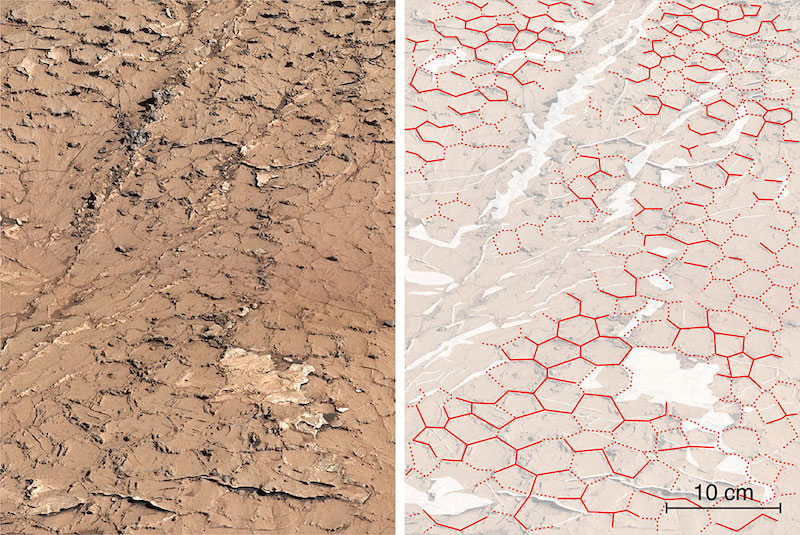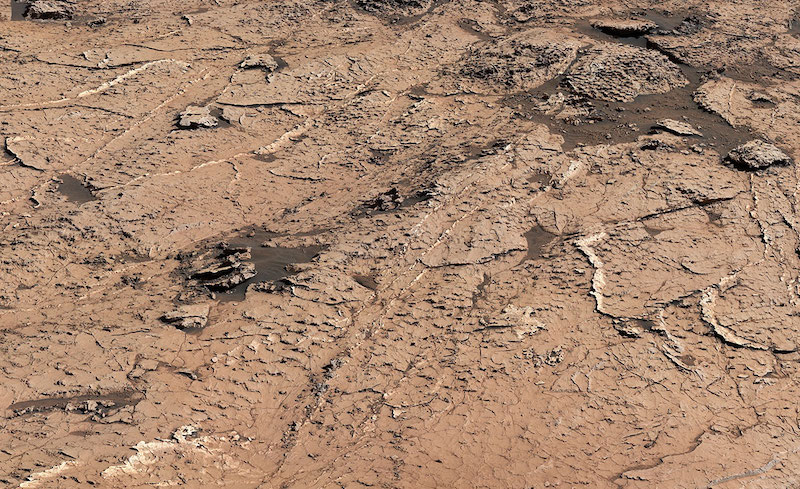
As we know, Mars was once a very wet place, with rivers, lakes and likely even an ocean. And of course, where there is water, there is also … mud. Mars rovers have seen traces of ancient Martian mud before, but now NASA’s Curiosity rover has come across what may be the best-preserved remains of mud cracks ever seen. These cracks – just like ones we see on Earth after mud has dried out – are not only well-preserved, but they also provide clues about certain conditions on Mars that could have helped microscopic life emerge billions of years ago. NASA announced the tantalizing findings on August 8, 2023.
An international team of researchers published a new peer-reviewed paper about the discovery in Nature on August 9.
Repeated wet-dry conditions
Like is often seen on Earth, the ancient mud, now bone-dry, is split into many cracks. The cracks form small hexagons, producing a honeycomb effect. This pattern hints at conditions that were repeatedly wet and then dry. That cycle was persistent and may have been seasonal, the scientists say. Lead author William Rapin of the Institut de Recherche en Astrophysique et Planétologie in France said:
These particular mud cracks form when wet-dry conditions occur repeatedly, perhaps seasonally.
The paper states:
We observe exhumed centimetric polygonal ridges with sulfate enrichments, joined at Y-junctions, that record cracks formed in fresh mud owing to repeated wet–dry cycles of regular intensity. Instead of sporadic hydrological activity induced by impacts or volcanoes, our findings point to a sustained, cyclic, possibly seasonal, climate on early Mars.
Curiosity first spotted the mud cracks back in 2021 while exploring ancient sediments on Mount Sharp in Gale Crater. The rover had just finished drilling a sample from a rock target nicknamed Pontours. This target was in a transitional zone between a clay-rich layer and one higher up that is enriched with salty minerals called sulfates. Notably, clay minerals typically form in water, but sulfates form as water dries up.
Scientists can learn more about the history of this region, since the different minerals highlight different eras in the history of Gale Crater. Likewise, the transition zone between them is a record of changing conditions from wet to long dry spells. This happened as the lakes and rivers in the crater began to recede and dry up.

How ancient mud on Mars formed hexagonal patterns
The process by which the hexagons formed is similar to that on Earth. As the mud dried out, it shrank and fractured into T-shaped cracks. Curiosity had seen these before, at a location called Old Soaker. Those fractures formed when the mud dried out only once.
But at Pontours, the mud dried out and became wet again multiple times. As a result, the T-shaped cracks gradually softened and became Y-shaped. Later, those cracks merged together to form the hexagonal, or honeycomb, patterns.
Curiosity also found that the cracks continued to form even as new sediments were deposited in the area. That means the cyclic wet-dry conditions must have continued for a long time. The cracks also have salty crusts on their edges. That helped to preserve them for billions of years.

Suitable conditions for life?
Although mud cracks have been seen before on Mars, these ones are even more intriguing. Why? The cyclic conditions were similar to ones that occur on Earth. That process is important for molecular evolution leading to life, as Rapin noted:
This is the first tangible evidence we’ve seen that the ancient climate of Mars had such regular, Earth-like wet-dry cycles. But even more important is that wet-dry cycles are helpful – maybe even required – for the molecular evolution that could lead to life.
For already-existing microorganisms, long-lasting bodies of water such as lakes are ideal. But scientists say that the conditions that lead to life are necessarily a bit different. Wet-dry conditions help to control the concentration of the needed chemicals that create polymers. Polymers are long chains of carbon-based molecules. This includes nucleic acids, chemical building blocks of life (at least on Earth).
The paper says:
Furthermore, as wet–dry cycling can promote prebiotic polymerization, the Gale evaporitic basin may have been particularly conducive to these processes.
Ashwin Vasavada, project scientist for the Curiosity mission, said:
This paper expands the kind of discoveries Curiosity has made. Over 11 years, we’ve found ample evidence that ancient Mars could have supported microbial life. Now, the mission has found evidence of conditions that may have promoted the origin of life, too.
Rapin added:
It’s pretty lucky of us to have a planet like Mars nearby that still holds a memory of the natural processes which may have led to life.
Bottom line: NASA’s Curiosity rover has discovered ancient honeycomb-patterned mud on Mars. The now bone-dry mud is evidence of cyclic wet-dry periods in Mars’ past.
Source: Sustained wet-dry cycling on early Mars
Further reading: Mars rover examines possible mud cracks
Further reading: On Mars, mud flows like lava
The post Ancient ‘honeycomb’ mud on Mars boosts chances for life first appeared on EarthSky.
from EarthSky https://ift.tt/r3KCO1E

As we know, Mars was once a very wet place, with rivers, lakes and likely even an ocean. And of course, where there is water, there is also … mud. Mars rovers have seen traces of ancient Martian mud before, but now NASA’s Curiosity rover has come across what may be the best-preserved remains of mud cracks ever seen. These cracks – just like ones we see on Earth after mud has dried out – are not only well-preserved, but they also provide clues about certain conditions on Mars that could have helped microscopic life emerge billions of years ago. NASA announced the tantalizing findings on August 8, 2023.
An international team of researchers published a new peer-reviewed paper about the discovery in Nature on August 9.
Repeated wet-dry conditions
Like is often seen on Earth, the ancient mud, now bone-dry, is split into many cracks. The cracks form small hexagons, producing a honeycomb effect. This pattern hints at conditions that were repeatedly wet and then dry. That cycle was persistent and may have been seasonal, the scientists say. Lead author William Rapin of the Institut de Recherche en Astrophysique et Planétologie in France said:
These particular mud cracks form when wet-dry conditions occur repeatedly, perhaps seasonally.
The paper states:
We observe exhumed centimetric polygonal ridges with sulfate enrichments, joined at Y-junctions, that record cracks formed in fresh mud owing to repeated wet–dry cycles of regular intensity. Instead of sporadic hydrological activity induced by impacts or volcanoes, our findings point to a sustained, cyclic, possibly seasonal, climate on early Mars.
Curiosity first spotted the mud cracks back in 2021 while exploring ancient sediments on Mount Sharp in Gale Crater. The rover had just finished drilling a sample from a rock target nicknamed Pontours. This target was in a transitional zone between a clay-rich layer and one higher up that is enriched with salty minerals called sulfates. Notably, clay minerals typically form in water, but sulfates form as water dries up.
Scientists can learn more about the history of this region, since the different minerals highlight different eras in the history of Gale Crater. Likewise, the transition zone between them is a record of changing conditions from wet to long dry spells. This happened as the lakes and rivers in the crater began to recede and dry up.

How ancient mud on Mars formed hexagonal patterns
The process by which the hexagons formed is similar to that on Earth. As the mud dried out, it shrank and fractured into T-shaped cracks. Curiosity had seen these before, at a location called Old Soaker. Those fractures formed when the mud dried out only once.
But at Pontours, the mud dried out and became wet again multiple times. As a result, the T-shaped cracks gradually softened and became Y-shaped. Later, those cracks merged together to form the hexagonal, or honeycomb, patterns.
Curiosity also found that the cracks continued to form even as new sediments were deposited in the area. That means the cyclic wet-dry conditions must have continued for a long time. The cracks also have salty crusts on their edges. That helped to preserve them for billions of years.

Suitable conditions for life?
Although mud cracks have been seen before on Mars, these ones are even more intriguing. Why? The cyclic conditions were similar to ones that occur on Earth. That process is important for molecular evolution leading to life, as Rapin noted:
This is the first tangible evidence we’ve seen that the ancient climate of Mars had such regular, Earth-like wet-dry cycles. But even more important is that wet-dry cycles are helpful – maybe even required – for the molecular evolution that could lead to life.
For already-existing microorganisms, long-lasting bodies of water such as lakes are ideal. But scientists say that the conditions that lead to life are necessarily a bit different. Wet-dry conditions help to control the concentration of the needed chemicals that create polymers. Polymers are long chains of carbon-based molecules. This includes nucleic acids, chemical building blocks of life (at least on Earth).
The paper says:
Furthermore, as wet–dry cycling can promote prebiotic polymerization, the Gale evaporitic basin may have been particularly conducive to these processes.
Ashwin Vasavada, project scientist for the Curiosity mission, said:
This paper expands the kind of discoveries Curiosity has made. Over 11 years, we’ve found ample evidence that ancient Mars could have supported microbial life. Now, the mission has found evidence of conditions that may have promoted the origin of life, too.
Rapin added:
It’s pretty lucky of us to have a planet like Mars nearby that still holds a memory of the natural processes which may have led to life.
Bottom line: NASA’s Curiosity rover has discovered ancient honeycomb-patterned mud on Mars. The now bone-dry mud is evidence of cyclic wet-dry periods in Mars’ past.
Source: Sustained wet-dry cycling on early Mars
Further reading: Mars rover examines possible mud cracks
Further reading: On Mars, mud flows like lava
The post Ancient ‘honeycomb’ mud on Mars boosts chances for life first appeared on EarthSky.
from EarthSky https://ift.tt/r3KCO1E

Aucun commentaire:
Enregistrer un commentaire